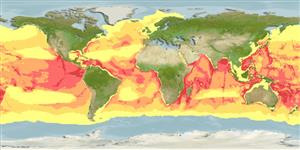Mammalia |
Cetartiodactyla |
Delphinidae
Environment: milieu / climate zone / пределы глубины / distribution range
экология
пелагический; мигрирует в океане (ссылка 75906); пределы глубины 0 - 5300 m (ссылка 116169). Tropical; 22°C - ? (ссылка 75906); 90°N - 90°S, 180°W - 180°E
Atlantic Ocean and Indo-Pacific: Stenella attenuata graffmani: Gulf of California and Colombia; Stenella attenuata subspecies A: Hawaii; Stenella attenuata subspecies B: Baja California Sur, Colombia. Tropical to temperate.
Length at first maturity / Size / Weight / Возраст
половая зрелость: Lm 182.0 range ? - ? cm Max length : 260 cm TL самец/пол неопределен; (ссылка 1394); 240 cm TL (female); наибольший вес (опубликованные данные): 120.0 kg (ссылка 1394)
Major threats to this species is incidental catches specifically by tuna fishermen in the eastern Pacific, and as sustainable by-catch with the use of gillnets in the Pacific and northern Indian Ocean (Ref. 85211). Spends the majority of their day nearshore, often between 90 to 300 m (Ref. 122680 but they also frequent oceanic waters (Ref. 801). They move further offshore at night into deeper waters to search for prey (Ref. 122680). Feeds largely on epipelagic fish and squid (Ref. 1394). It associates with parasites such as nematodes, cestodes, trematodes and acanthocephalans and commensals that includes cyamids amphipod, and barnacles (Ref. 85211). Social groups are formed by a range of a few individuals to thousands. It is composed of cow-calf pairs, adults and juveniles and they are grouped together or separately by juveniles or breeding groups. Their school size varies within the day (Ref. 85211).
Основная ссылка
ссылки | координатор | соавторы
Tan, J.M.L. 1995 A Field Guide to the Whales and Dolphins in the Philippines. Makati City: Bookmark. 125 p. (ссылка 936)
Статус Красного Списка МСОП
(ссылка 130435: Version 2025-1)
Статус СИТЕС (ссылка 108899)
CMS (ссылка 116361)
Угроза для людей
Использование человеком
рыболовство: коммерческий
FAO - рыболовство: landings, Видовой профиль | FishSource | Sea Around Us
инструменты
дополнительная информация
PhysiologyOxygen consumption
Human RelatedStamps, coins, misc.
ресурсы в Интернет
Estimates based on models
Preferred temperature
(Ref.
115969): 2.3 - 5.6, mean 3.5 (based on 2741 cells).
устойчивость к внешним воздействиям
средний (среднего размера), минимальное время удвоения популяции 1.4-4.4 года (K=0.2-0.37; tm=12).
Fishing Vulnerability
Very high vulnerability (77 of 100).
Категория цены
Unknown.
